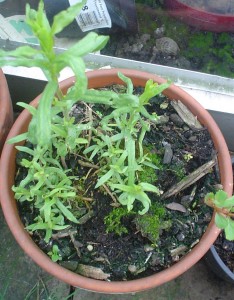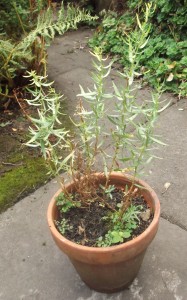 From a small cutting taken this spring, my tarragon has grown into this:
From a small cutting taken this spring, my tarragon has grown into this:
 This is the French tarragon, which you are always told to ask for, rather than the Russian. Russian tarragon is hardier and can be grown from seed in this country, but has not the special distinctive taste which makes this herb so special. Sometimes you get pictures which aim to show you the difference between the two, but I’ve never been able to work it out. The bottom line is to buy plants, not seeds, and rub the leaves of any plant you are offered. If you like the smell, you’ve probably got the ‘true’ French tarragon.
This is the French tarragon, which you are always told to ask for, rather than the Russian. Russian tarragon is hardier and can be grown from seed in this country, but has not the special distinctive taste which makes this herb so special. Sometimes you get pictures which aim to show you the difference between the two, but I’ve never been able to work it out. The bottom line is to buy plants, not seeds, and rub the leaves of any plant you are offered. If you like the smell, you’ve probably got the ‘true’ French tarragon.
It is one of the ‘fines herbes’ used for omelettes and salad dressings, and is often paired with chicken. It makes an excellent vinegar, which is good for vinaigrette. The taste is distinctive, somewhere between liquorice and aniseed, and you either like it or you don’t. It hasn’t much use in medicine, though it is comforting to the digestion, but was once planted as a cure for the bite of snakes or dragons. In fact the name ‘tarragon’ means, via Greek and Arabic, ‘little dragon’.
It’s tricky to grow so far north. It likes warmth and sun, and light, but rich soil, and it hates getting waterlogged. I usually make sure I overwinter it in the greenhouse, but I notice that Audrey Wynne Hatfield, whose book The Magic of Herbs was my first introduction to this project, says that ‘a lot of tarragon plants survived the severe winter of 1962-3, in districts where a number of herbs considered to be more hardy succumbed.’ This autumn, which has been so dry, might be just what my herbs need.
Leave a Reply